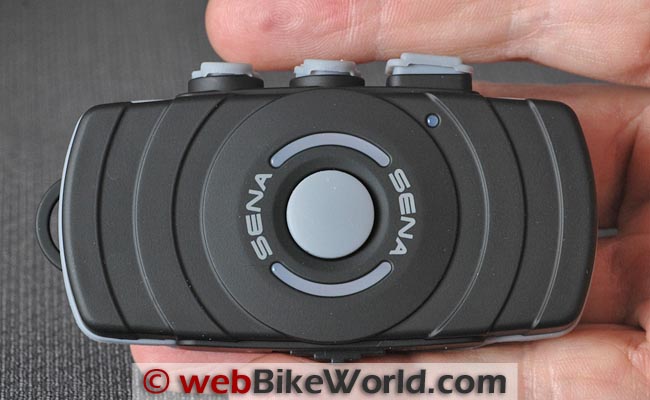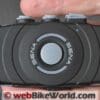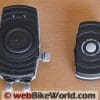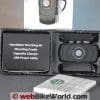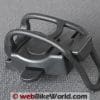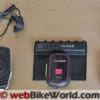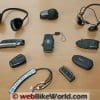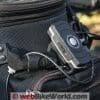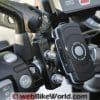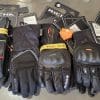The Sena SM10 Dual Stream Bluetooth Stereo Transmitter is a timely and cost effective solution that allows both a rider and passenger to share audio from connected devices.
This includes portable music players, navigation and radar warning devices and even wired motorcycle sound systems.
Basically anything that has a physical (wired) audio output or headset jack can now be shared by both the rider and passenger!
The Sena SM10 was announced at the 2012 Dealer Expo (report) and a Sena SM10 Preview was published on webBikeWorld at that time.
The SM10 is a Bluetooth stereo adapter that supports two connected devices and allows both the rider and passenger to hear the audio output simultaneously in stereo or mono audio.
This means that both the rider and passenger can listen to the same music, GPS navigation instructions, radar warnings and more. That’s right: the SM10 allows both you and your passenger to share the same music stream, GPS instructions and more!
The SM10 has an audio in port for stereo audio and an auxiliary port, typically used for mono audio devices. The ports allow connectivity to a wide range of devices or on-board systems with stereo or mono output ranging from music players to GPS, radar detectors or, yes, even your old 8-track!
This capability addresses a very real and long-standing request of webBikeWorld motorcycle intercom users. Although not the first to provide this capability, Sena is the first to make it available at a reasonable price.
So far, the Sena SM10 has successfully paired with and streamed outstanding quality audio to every Bluetooth headset (helmet or personal) or speaker system I have put in front of it. Outside of some AVRCP function limitations (possibly addressable via firmware updates), the SM10 is a near-perfect example of how technology makes our moto-experience that much better.
Sena SM10: The Newest (and Smallest) Member of the Sena Bluetooth Family
Getting slightly ahead of myself, a typical SM10 configuration serves to illustrate how it works. Let’s say that you’d like to share music and GPS instructions with your passenger. To do that, connect an MP3 player (or an iPhone 4S, etc.) to the “AUDIO-IN” port on the SM10 and connect your GPS to the AUX port.
The music will then stream to both the rider’s and passenger’s Bluetooth intercom headsets. When the GPS decides its time to give you some instructions, the SM10 will lower the music audio volume and the navigation instructions will be heard by both the rider and passenger. When the GPS instructions end, the music returns at the previously set volume.
The SM10 is small enough to be carried or stashed almost anywhere and it provides a full day of output from its internal battery. Or, you can use the included 12V DC (cigarette-style) charger, or any of the other custom power solutions offered for the Sena adapters for nearly unlimited battery life while riding.
The SM10 is the smallest member of the Sena Bluetooth family so far. For the technically-minded webBikeWorld reader, it uses Bluetooth 2.1+EDR, which provides mono and stereo audio streaming for two intercom headsets using the A2DP and AVRCP profiles.
Once more — in case you missed the preview or have missed the ongoing excitement over this little gem, you read this right: two motorcycle helmet intercom headsets can now listen to the same audio, courtesy of the dual-stream Bluetooth capability of the Sena SM10.
The SM10 is actually a very simple hub device, supporting audio from two wired devices that is mixed and then broadcast as two dedicated Bluetooth audio streams.
Difference Between the Sena SR10 and SM10
Just to note, readers need to be very clear about the differences between the similarly-named Sena SR10 Bluetooth Adapter (review) and the new SM10.
The SR10 Bluetooth adapter is a simple multi-connection hub that combines audio from all connected sources, including two-way radio using its Push-To-Talk capability, into one mono or single channel Bluetooth stream to one compatible paired Bluetooth headset.
The Sena SM10 is also a simple connection hub for two devices, but it supports and streams both stereo and mono audio simultaneously to two paired headsets, with prioritized audio features.
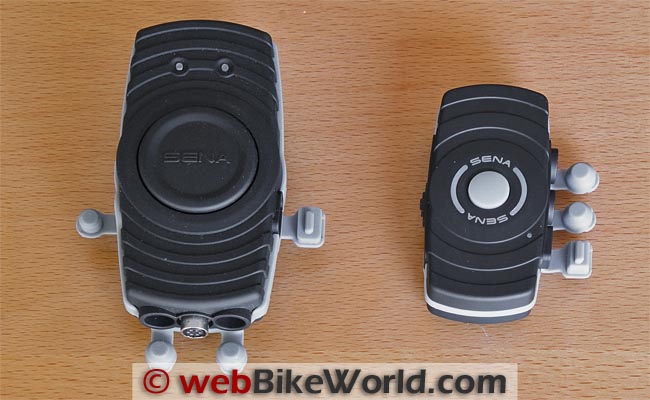
Sena SM10 Overview
With two input ports (labeled “AUDIO-IN” and “AUX”), the SM10 supports a mix of stereo and mono audio sources. The “AUDIO-IN” port supports MP3 players, smart phones or on-board audio systems — all of which can provide stereo or mono audio.
The “AUX” port provides connectivity for other devices, such as radar/laser detectors or navigation devices.
The SM10 also connects to wired motorcycle radio/speaker systems, such as those found on some Harley-Davidson, Honda (Gold Wing) and other bikes. The connection is provided via the optional Sena interface cables, both of which were included in our evaluation.
The cables feature a 3.5 mm stereo jack and a multi-pin DIN connector; seven (7)-pin for the Harley Davidson Ultra Classic cable and five (5)-pin for the Honda Gold Wing cable. Other cables are sure to follow.
As with other Sena products, the SM10 is water-resistant (no certification identified) and of course, firmware upgradeable. The now-standard Sena two year warranty provides a further measure of comfort regarding continued use.
The rated operating time for the SM10 — confirmed through my day-to-day use — is right around eight hours, with a stated standby time of three days. Battery charging can take up to three hours, although typically it recharges in less than two hours after being nearly completely discharged. Recharging time also depends on whether it is trickle charged via PC USB or from an AC/DC adapter.
Each SM10 kit contains the SM10 Dual Stream Bluetooth Stereo Transmitter Main Unit or module; a USB power and data cable, two 3.5 mm stereo audio cables (one 4-pole and one 3-pole); a strap-on handlebar mounting kit; an adhesive mounting cradle; a cigarette charger; and a pocket-sized owner’s manual.
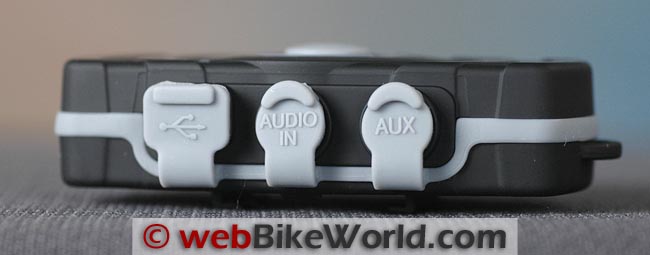
Sena SM10 Form and Features
The SM10 really is the smallest member of the Bluetooth adapters we have reviewed on webBikeWorld; it is half the size of its larger sibling the SR10 and somewhat smaller than the UClear WT300 Bluetooth adapter (review).
At 83 mm long, 45 mm wide and 25 mm tall (3.3 x 1.8 x 1.0 in.), the SM10 fits completely in the palm of the hand. Two precision moulded plastic halves form the shell while an integrated bumper guard and port plug component strip seals and protects the two halves. Four small recessed Phillips-head screws on the back keep the moulded pieces together.
Like the Sena SR10 Adapter (review) kit, the SM10 kit contains two mounts: an adhesive plate mount and a rubber handlebar band, similar to the SR10 component (photo below).
Small parallel slide rails located top and bottom of centre on the back provide the platform for the snap-in mount used on the adhesive backed or rubber strap handlebar mount components. The rubber strap piece is similar to that provided with the SR10 but it now fits into the snap-mount that has a small rubber anti-skid insert on the inner curve that limits movement (rotation) when mounted on a handlebar or something similar in shape.
Unlike the SR10, however, the newer SM10 mounting pieces now slide and lock into place on a set of rails moulded into the back of the module. This makes it quicker and easier to mount the SM10 and there are no more tiny screws to deal with.
Viewed from the front, a heavy duty On/Off slider control dominates the left side while three ports occupy the right side; (top to bottom) a 3.5 mm AUX port; a 3.5 mm AUDIO-IN port and a micro-USB port for charging and data (firmware updates).
The front surface of the SM10 houses a round and slightly-raised pairing indication button framed by curved half-circle blue and red LEDs on the left and right sides respectively, with a small charging LED indicator on the right front as well. The reset button resides in a tiny recess on the back of the unit.
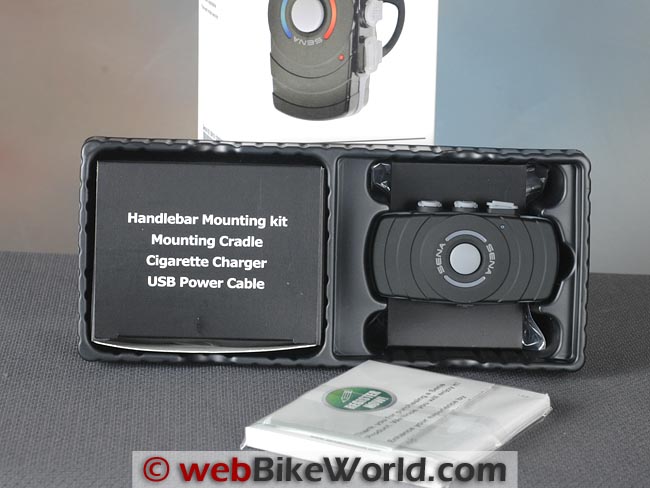
Sena SM10 Setup
SM10 setup, as with most Bluetooth devices today, is simple and fast — no muss, no fuss and with positive results. A push of the power switch brings the SM10 to life with the LEDs glowing in a steady-on state.
Despite the claim that the first helmet pairing is automatic, it isn’t really — a five second push on the pairing button is needed to put the blue LED into a rapid flashing state, indicating pairing mode for the first headset. A nine- to ten-second push on the button causes the red LED to go into its rapid dance for pairing the second helmet.
Individual helmet pairings on average took five seconds, with the longest, the Midland BT Next (review), taking 12 seconds. The UClear HBC100 (review) was the speed champion at two seconds flat.
As expected, every Bluetooth headset or audio device paired successfully and, after many (many) individual pairings, only twice was it necessary to re-do a pairing. Many manufacturers and users, including myself, recommend using the “pair then reboot” approach; I purposefully did pair-and-reboot tests and “hot pairings” on the fly, and neither approach made any difference; everything just worked. The Midland was cranky after a hot pairing, but once rebooted, it worked just fine.
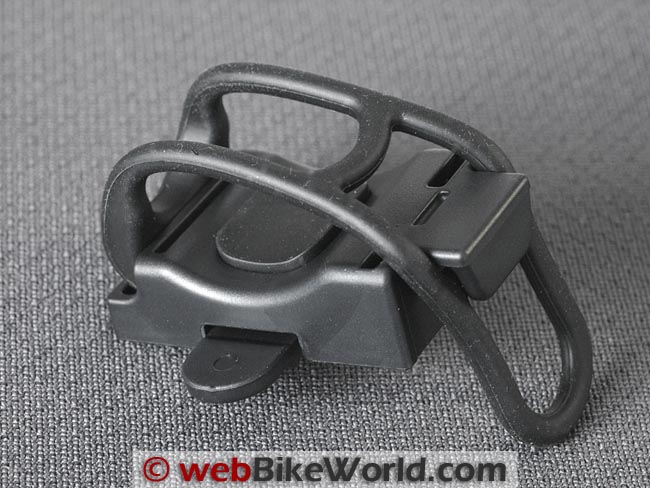
Using Wired Radio/Speaker Systems With the Sena SM10
For owners of motorcycles with on-board radio/speaker audio systems, the SM10 is a very timely and welcome device, in that it provides an affordable and easily configured method to allow two Bluetooth intercom systems to share the music output, rather than having to listen to the music through the speakers.
Some motorcycles (e.g., Harley-Davidson, Honda and others) have a wired audio system with a radio and speakers built into the fairing. Sena has optional cables for the SM10 that can also connect this type of system to a pair of Bluetooth intercoms.
Other manufacturers, such as BMW, take the wireless (Bluetooth) approach to their motorcycle sound systems.
But this wireless (Bluetooth) approach (at least when using third-party headsets) is limited to one user, typically the rider. Such is the case for the very popular BMW R1200RT and very new six cylinder BMW K 1600 GT/GTL (report), which is equipped with the BMW on-board audio system. That system is designed for one user only, unless the very expensive BMW helmets and/or headsets systems are purchased for both the rider and passenger.
The inexpensive and expedient solution? Why the Sena SM10 of course! It provides the ability to host an audio output from the BMW connection and stream it to both rider and passenger. But that missing audio output now become critical…
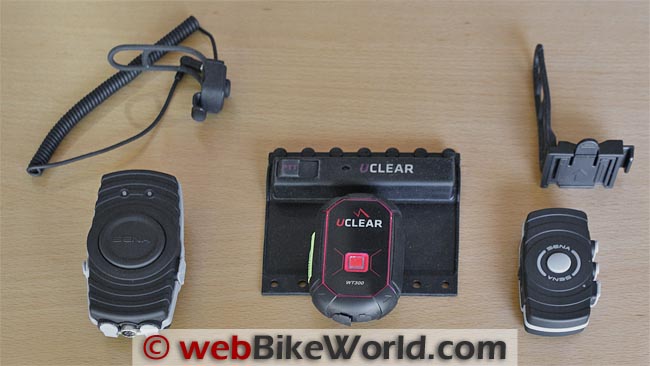
On the Road With the Sena SM10
The SM10 is so functionally simple that most users will spend far more time actually connecting their devices than getting the SM10 up and running — not a bad thing at all.
Where to put the SM10? Well, it will fit almost anywhere, with the only real limitations being Bluetooth range, power requirements and electrical or physical interference considerations.
A typical SM10 configuration sees the iPhone 4S or an on-board audio system, like that found on the BMW K1600GT/GTL (now via the Autocom output; see the Owner Comments section below) connected to the AUDIO-IN port of the SM10. Other devices like the Garmin zumo 665 (review) or non-Bluetooth audio connected to the AUX port.
Like other switched systems, the SM10 works best if everything is connected first, with one of the audio sources, like the music player, activated before turning the headsets and then the SM10 on. Reasoning: the audio input provides the detection or activation signal used by the SM10. If all is done right, once the SM10 is turned on, audio streaming to the paired headset(s) will be almost instantaneous.
In the rare instance where audio streaming doesn’t start immediately, a quick tap on the pairing button results in audio streaming being initiated within a couple of seconds.
With the Sena SMH10B (review) intercom system (and possibly other Sena systems), a tap on the “Jog Dial” usually serves to refresh the connection and initiate audio streaming from the SM10.
Audio streaming is effective out to 20 metres (66 feet) on average. When the limit is reached, audio drops cleanly, without any noise or reduced audio quality like that experienced with some intercom systems; moving back inside the coverage area results in instantaneous resumption of the audio.
Quality of the audio is outstanding, although this is somewhat subjective and dependent upon the capabilities of the Bluetooth headset being used.
My favourite (best) helmet listening environment is the SMH10B using the optional A0303 mount, with the superb iAsus GP3X2 speakers (review) connected via the 3.5 mm audio output jack. At lower speeds — and with the right cockpit environment — audio delivered by this configuration is outstanding.
One of the most appreciated features of the SM10 is its unfailing ability to hot-pair with any headset; even if two riders or rider and passenger use different headsets, for whatever reason, the SM10 still accommodates.
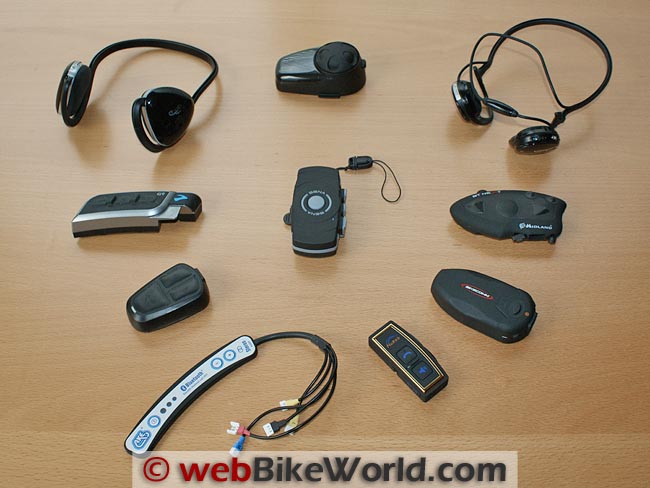
Sena SM10 Audio Activity Management
As an example, with a portable music player and a GPS (such as the Garmin zumo 665) connected to the SM10, anything connected to the SM10’s “AUDIO-IN” port will be heard in the foreground at the set volume level.
When the GPS (which is connected to the SM10’s “AUX” port) activates to give a spoken instruction, this becomes the louder or foreground audio, with the music going to a lower or background volume level. Once the AUX audio ends, the AUDIO-IN or music resumes at its original volume.
But for this foreground/background audio feature to work properly, some adjustments in respective audio outputs are needed.
For example, with the Garmin zumo 660 or 665 connected to the auxiliary port, device output had to be at 70 to 90 percent in order to be high enough to activate the foreground/background feature. If the levels are not carefully adjusted, both audio sources will be heard in the headsets, with one slightly more dominant and the other just hard to discern — you don’t want to miss that critical navigation audio instruction do you?
And for times when the “AUX” source is a bother, a two-second press of the pairing button will mute or un-mute the source…just something you should know.
The current SM10 User Guide does identify the ability to configure the (discrete) volume levels by using manager software, but even with the first firmware update released, this “feature” isn’t available (yet). Over to Sena on this one…
Virtually any configuration supported by the SM10 and headsets are viable options, including bringing additional devices and adapters into the configuration, particularly those that allow or have multi-point (simultaneous support of two headset/hands-free connected devices) or Selective Pairing configurations unique to Sena Bluetooth systems – play time never really ends and is limited only by the imagination.
And speaking of Selective Pairing, it is worth its weight in gold. This feature, unique to Sena Bluetooth systems provides the ability to discretely pair a device using one profile (a mobile phone or smart device that is only needed for phone functions can be paired using only the Headset/Hands-Free profile), leaving other Bluetooth profiles available for use with other devices. For multi-device configurations it is the optimal way to go.
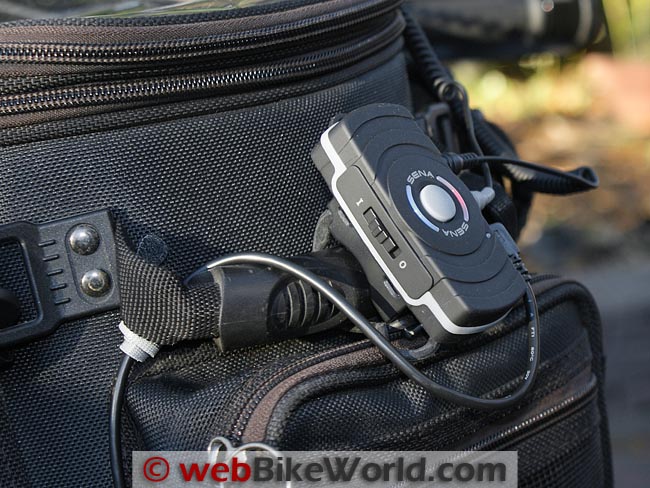
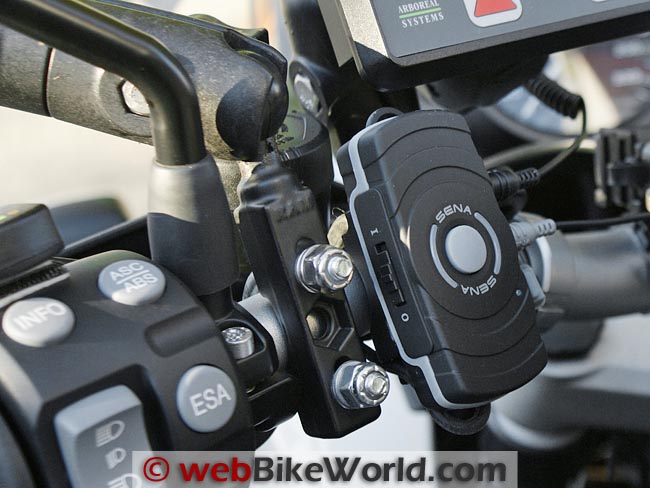
MP3 Issues
Although the Sena SM10 User Guide clearly states that some Audio/Video Remote Control Profile (AVRCP, which is the play, pause and forward-backward track selection used to control music streaming) functions for a compatible music player are not available when using the SM10.
This is an understandable situation, given that the SM10 is really a one-way broadcast device. The SM10 forward and back controls are supposed to work with some players, but so far I haven’t managed to get anything AVRCP-related working, even with the Sena headsets…maybe a subsequent firmware release will shed light on all of this.
Sena SM10 Compatibility
So far, the SM10 has been successfully used with the following Bluetooth intercom communications systems:
- Sena SMH10 (review) (both A and B versions).
- Cardo Scala Rider G4 (review).
- Cardo Scala Rider G9 (review).
- BikeComm Hola S10 and F10 (review).
- UClear HBC 100 (review).
- Midland BT Next (review).
- HuRob HSB S100B (review).
- AKE Stealth Intercom 200 (review).
- Chatterbox XBi (review).
- Chatterbox XBi2 (review).
A couple of older systems need to be ‘rejuvenated’ and then they will be put up against the SM10 as well. In the near term the new UCLEAR HBC200 system should be a candidate system as well.
UPDATE: Another new feature, provided under the initial SM10 firmware release just announced, is the very useful “Audio Boost”. It provides a significant audio assist that can be very useful when using connected devices that have low or fixed outputs.
Activated or deactivated by a double tap of the SM10 pairing button, Audio Boost really works — just make sure to reduce headset volume settings before initiating the feature and then go from there with fine tuning.
|
webBikeWorld Overall Opinionator: Sena SM10
|
|
|---|---|
| Picks… | …and Pans |
|
|
Conclusion
To make a long story short, having a pair of the Sena SM10 systems on hand has been a great learning and sharing experience.
The number of local riders who have inquired, by phone, email or in person, has far exceeded the interest I have experienced with any other product. This fact alone attests to the fact that Sena continues to up the ante in providing simple and cost effective Bluetooth headsets and adapters to make our riding lives that much better, and safer.
The SM10 can be mounted, stashed or carried just about anywhere on the motorcycle, rider or passenger, run of its battery for a full day, or powered by a switched 12V DC source or from a convenient USB outlet — which is why I have at least one installed on every motorcycle in the home fleet.
For providing virtually flawless wireless dual-stream stereo audio from common audio sources the widely available and attractively-priced, especially regarding what it brings to the audio table, the Sena SM10 is the clear leader and winner in providing shared audio for two headsets.
So what will Sena do next? I can hardly wait. But I can perhaps wish for a super-system that has increased capacity to support streaming of audio via one headset to another, basically integrating the dual-stream functionality. How about a combined SR and SM module?
More: wBW Motorcycle Intercom Reviews | wBW Reviews Home
Owner Comments and Feedback
See details on submitting comments.
From “D.E.” (November 2012): “I love it! And I get to bypass the BMW proprietary data stream on my K1600 designed to insure you use their headset. I clearly connect my iPhone 5, listen to music, and get turn by turn directions from my GPS (Garmin/Motorrad Nav IV). No need for the bikes system at all. And no loss of pairing. The speakers and mic are great.”
From “J.P.” (November 2012): “My wife and I have been using the SMH10 for 2 season now and are very happy with the units overall. The SM10 looks like a perfect way to add back the music functionality that was lost when switching from our Autocom system to the SMH10.
Your review did not discuss how the intercom function of the SMH10 works in relationship to the audio inputs when paired to the SM10. Does the intercom lower the volume of the audio inputs during the conversation, cut out the audio, or operate in some other way? Keep up the good work, love the site.
H.B.C.’s Reply: The interaction between the SM10 and paired headsets, was identified in the Audio Activity Management section of the review and some related information provided in my reply to the comment from “S.G.” below.
But for clarity, revisiting functionality is never a bad thing and your question is timely — there are lots of questions and postings being made regarding the SM10 and the SMH10 headsets; it seems many users expect a Sena with Sena configuration to provide some tangible benefits above and beyond what the SM10 is (currently) capable of.
The SM10 with paired Bluetooth headsets, like the Sena SMH10 systems, does indeed provide the means to restore audio distribution functionality originally provided by a wired or hybrid system such as the Bikecomm BK02 (review) (Review Part Two pending).
With the SM10 paired to one or two SMH10 headsets and the audio output of connected devices adjusted to provide the desired foreground/background levels when the SM10 switches between Audio-In (music) and Aux-In (navigation) audio, the SM10 streams audio directly to the headsets in stereo or mono depending on the source.
As the SM10 is a one-way transmitter, it streams stereo audio from the device connected to the Audio-In port, and when audio from the Aux-In connected device is detected, such as navigation instructions, that audio becomes louder with the stereo music audio lowered to a background level.
Once the Aux-In audio ends, the music audio resumes its original or foreground level as the primary audio from the SM10. The audio stream from the SM10 to the headsets utilizes the A2DP profile, which is assigned as Priority 4 by the SMH10 headset ((1 – mobile phone, 2 – intercom, 3 – music via wired input and 4 – music via Bluetooth).
So when a phone call comes or the intercom is active, the SM10 audio stream is interrupted (cut) rather than muted. Once the call is ended or the intercom session terminated (by time in VOX mode, or manually), audio from the SM10 resumes almost immediately. If it doesn’t, a quick push of the Pairing Button on the SM10 restarts the streaming in one or two seconds.
This (current) limitation is due to two primary factors: audio priorities of the SMH10 and a “set” priority within the SM10. These hard-coded rules prevent Aux-In audio, like navigation instructions, from being heard if the mobile phone link and/or the intercom is active on the headset.
This limitation is frustrating particularly as the SMH10B headset (starting with firmware v4.0) actually supports a three-way conference capability between a Phone caller – Headset 1 and when the intercom link is activated, Headset 2.
The SR10 Solution: if the requirement or desire is to have an active intercom along with “other” audio (background or otherwise), the Sena SR10 Bluetooth Adapter (review) provides a solution, as it takes audio from all connected sources and mixes it into a single channel for streaming; but only in mono and only to one paired headset.
Relevant to pairing and performance, users need to be aware that if pairing issues arise, a factory reset of the devices — like the SMH10 and SM10 — provides a “clean” environment before attempting pairings.
The other (very) important thing to remember is that the Last In/First Out (LIFO) rule applies; therefore the SM10 will try to connect to the last paired device first, which is no different than how most Bluetooth connections work, including when multiple headsets are paired for two-, three- or four-way conferencing.
The following step-by-step is an example of how to optimize the SM10 and SMH10 relationship with peripherals:
Step 1: Do a factory reset on the SMH10 headsets and (preferably) on the SM10 as well, turn the devices Off.
Step 2: Turn On the peripheral (smart device/phone) and SMH10 headsets and pair them; the HFP and A2DP profiles will be used (phone and media announcements).
Step 3: Turn On the SM10 and pair it to the desired SMH10 headset or headsets; the A2DP profile will be used (keep the last in/first out or LIFO rule in mind here).
Step 4: Turn the devices Off, and…
Step 5: Turn the Audio-In peripheral On and activate its audio output as connected to the SM10, now turn on the SM10, followed by the headsets.
In this configuration, the SMH10 headsets connect to the SM10 first using the A2DP profile and then the SMH10 with device connection takes place using the HFP profile. The last-in, first-out rule keeps peripherals, like my iPhone 4s, from taking and locking up all available profiles and, it eliminates the need to use the Selective Pairing feature of the Sena headsets.
This step-by-step has worked with every headset so far. I’m still doing some testing with all of this in mixing headsets, adapters like the SM10 and SR10 and various peripherals to see what is tolerated, and what isn’t
For what its worth though, an SM10 paired to a set of Midland BT Next (review) systems provides most of the capabilities requested by users — but I wish Midland would get a firmware release published…
And to perhaps expound on the thoughts of users (myself included), it would be great if Sena and other manufacturers would provide users the ability to a.) Change the audio priorities of a headset (something attempted by one manufacturer a long time ago); and b.) Allow the “mixing” of audio (A2DP music as foreground/background with concurrent intercom session), appreciating profile/streaming limitations.
With the ability to tweak the system or add new features via firmware updates, these two enhancements (for starters) would cure a lot of configuration issues…
From “S.G.” (October 2012): “My setup is simple. The bike is a (Kawasaki) Concours 14 (with Garmin) Zumo 550 (way better than 665 which I have sopped using, but don’t let me start on that subject), XM satellite radio through the Zumo, iPhone and a pair of SMH10’s. The phone is connected to the SMH10 via Bluetooth.
So, in order to stream stereo music from the Zumo, I used a Sony BT dongle, hard wired to the Zumo 3.5 mm outlet, and paired to one of the SMH10’s. The setup was great with ample volume. As a matter of fact, I only needed to have he Zumo volume only 3/4 max and could hear the music very well, even with 32 dB earplugs. The drawback: only one headset could be paired to the Sony dongle.
So, I heard about the SM10. A Sena BT transmitter that could stream music to two headsets. What could be better? After all it is a Sena product and is about three times the size of the Sony dongle. It has to be the perfect and most powerful device out there, right? I promptly ordered the device.
As I took out of the neat packaging, my expectations were high. I connected it to the Zumo using one of the supplied cables, paired it to he headsets easily and went for a ride. With same earplugs I could hardly hear the music at 30 MPH. A little faster and I could hear nothing. The Zumo volume is now maxed out to no avail.
I disconnected the SM10, went back to he Sony Dongle and quickly head to turn the volume down. I was very disappointed, but thought may be I was doing something wrong. I went to the Sena forums, and sure enough several users had the same problem.
Sena responded in a rather peculiar way, suggesting the device was primarily designed for HD, GW and BMW built in sound systems. This response made some SM10 users quite angry. I suggest you visit Sena web site to verify my story. Sena introduce a firmware update, the “audio boost” which helped some, but not much.
The problem seems to be hardware related, so I strongly doubt it’s a fixable problem. I guess if you don’t use earplugs the volume may be sufficient. I value my hearing to much and would like to keep it for a few more years. I am sorry, but I cannot recommend this device as it falls short of performing its primary function, streaming music, adequately.”
H.B.C.’s Reply: If I had noticed, or if any of the five users who have now used and are using either of the SM10 systems, any audio differences or issues, it would have been reported.
In fact, we did some comparative (subjective) testing with both systems, using the same two audio devices set to the same output level connected to both SM10s, and then used with two different helmets with two different headsets set to the same volume level.
And outside of some individual hearing loss between the users, everyone actually said that the SM10 did not detract and in fact seemed to boost the audio slightly compared to the same audio setting using a hard-wired or Bluetooth paired device to the headsets.
What I did find during my evaluation — and as confirmed by other users — is that indeed the output level or capability of the device that is connected to the SM10 (e.g., music player, smart phone, navigation device, etc.) is critical, as noted in the article.
This could be the nexus for Sena having added the “Audio Boost” feature with the initial SM10 firmware release, and to perhaps address the complaints, which I have been tracking.
So where my experience, and that of others, has been positive regarding SM10 functionality, including audio performance, I also know that others will get different results that are frustrating and disappointing.
I can state that the audio output from the zumo 550 (still an excellent device) is far less than it should be, and in having used it some time ago with a dongle, audio output was weak compared to newer devices, especially the zumo 660 and 665. I will continue to perform more device testing and will report back if I find anything of significance.
From “M.G.” (October 2012): “You mention in your review that the Sena SM10 can be used with the BMW K1600 GT. How do you hook this up as there is no hard wired output from the system? This would be the answer to many of us as the current BMW Bluetooth output is really poor when it comes to sound quality and does not allow the passenger to here the same music.”
Editor’s Reply: Here’s some info on that from H.B.C., I neglected to add it to the original posting:
Reply From H.B.C.: Thankfully there are solutions to the output requirement, with one (or two) very attractive options being the Autocom Factory-type Stereo Music Lead 2273 and 2275 kits. Both kits provide the means, and instructions, to tap into an on-board speaker system which then allows the integrated 3.5 mm audio output lead to fulfill its destiny as an audio source for the SM10.
The only real difference between the two kits is that the 2273 kit is meant for use on motorcycles without speakers, while the slightly more complex and more expensive 2275 kit has additional wiring with a switch for choosing between speakers or the audio output port, so that only one output is active at a time. For most owners, the latter kit will be the better solution.
Here’s the reason: With the 2273 kit, the audio output is sent to the speakers and the output jack simultaneously; a bit disconcerting given the delay between the output from the on-board speakers and the wireless broadcast by the SM10 to the headsets. Needless to say, the Autocom 2275 kit with the speaker cut-out switch is preferred.
I have installed one of the Autocom Factory-type Stereo Music Lead, Part 2273 (Autocom .pdf with information on the 2273 and 2275) kits on a BMW K1600GTL. The owner has been using one of the SM10 evaluation units since early summer with a smartphone; both he and his passenger were eager to get the on-board system added as a connection option for the SM10. A 2273 kit was sourced from RocketMoto and it provided the harness, instructions and four red Posi-Taps, and fifteen minutes later the output was working (the owner is going to replace the 2273 kit with the 2275 kit to have the speaker cut-out).
After some careful removal of panels and routing of the output lead down to the right-side glove box, where the BMW USB and AUDIO-IN leads are located, the work effort was just at the one hour mark. And better yet, there is room for the SM10 as well — nestled inside, drawing power from the USB connection.
Another minor issue: the Autocom 3.5 stereo connector is a loose fit in the recessed SM10 Audio-In port, whereas a higher quality gold-plated connector is a secure fit with solid contact made. Maybe Sena will add some interconnection adapters to their options list.
From “T.Z..” (October 2012): “The review states the firmware upgrade is not Mac compatible. It is now, but there was a trick to make the installer work.
When I download the file to install the software on a Mac running 10.8 (Mountain Lion) and Firefox 16.0.1, the downloaded file is download.php; but this did me no good. I needed to go to the file and change the extension to .pkg, so the file will be called download.pkg.
Double click on download.pkg after you change the extension and everything works fine.”
Editor’s Note: Just for the record, it is not stated anywhere in the review that the firmware was not Mac compatible.


